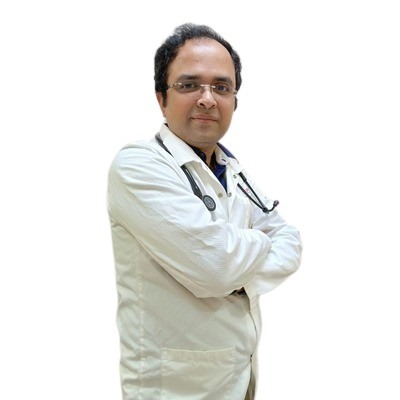Best Doctors for Epilepsy Treatment in Kolkata
Epilepsy
Epilepsy is a neurological disorder marked by recurrent unprovoked seizures stemming from abnormal electrical activity in the brain. Find the best doctors for Epilepsy in Kolkata on Skedoc. We will help you to find top doctors for Epilepsy disorder in Kolkata.
61 Doctors for Epilepsy Treatment found
Ward No-95, Premises No. 130
Netaji Subhas Chandra Bose Road, Tolly Exotica Building
Tollygunge, Kolkata
Get directions

OP Timings
Mon - Sat | 03:00 pm - 04:00 pm |
Fee : 750
66 , NSC Bose Road
Rajwada Estate , Mahamayatala
Garia, Kolkata
Get directions

OP Timings
Mon,Wed,Sat | 03:00 pm - 04:00 pm |
Fee : 750
Ekta Heights, 56, Raja Subodh Chandra Mallick Rd
near BaghaJatin Ramkrishna Upanibesh
Jadavpur, Kolkata
Get directions

OP Timings
Mon,Fri - Sat | 06:00 pm - 07:00 pm |
Tue | 05:00 pm - 06:00 pm |
Thu | 04:00 pm - 05:00 pm |
Fee : 750
90
Kalitala Rd, Near SBI Bank
Kalikapur, Kolkata
Get directions

OP Timings
Wed | 12:00 noon - 01:00 pm |
Fee : 750
507, NSC Bose Road
Adyasakti Complex
Narendrapur, Kolkata
Get directions

OP Timings
Mon - Sat | 04:30 pm - Onwards |
Fee : 1500
231/1 , NSC Bose Road, Near Sparsh More
Naktala , Netaji Nagar
Bansdroni, Kolkata
Get directions

OP Timings
Mon - Sat | 03:30 pm - Onwards |
2438, Garia Place
Garia Station Road
Garia, Kolkata
Get directions

OP Timings
Fee : 1000
E-1/1, BP Township
Next to Patuli Spencers
Panchasayar, Kolkata
Get directions

OP Timings
Mon - Sat | 05:00 pm - 06:00 pm |
Fee : 700
360
Pancha Sayar Rd
Panchasayar, Kolkata
Get directions

OP Timings
Mon - Sat | 09:00 am - 05:00 pm |
Fee : 1000
View Profile
Suraksha Clinic & Diagnostics
Tollygunge
Ward No-95, Premises No. 130
Netaji Subhas Chandra Bose Road, Tolly Exotica Building
Tollygunge, Kolkata
Get directions

OP Timings
Thu | 12:00 noon - 01:00 pm |
Fee : 1500
View Profile
Suraksha Clinic & Diagnostics
Ballygunge
1st Floor, One Sunny Park
Sunny Towers, 43, Ashutosh Chowdhury Ave
Ballygunge, Kolkata
Get directions

OP Timings
Thu | 06:00 pm - 07:00 pm |
Fee : 1500
36 , Vivekananda Road
Debigarh , U B Colony
Dunlop, Kolkata
Get directions

OP Timings
Fee : 1200
Suraksha Clinic & Diagnostics
Phool Bagan
P- 118
C.I.T Road
Phool Bagan, Kolkata
Get directions

OP Timings
Tue,Fri | 03:00 pm - 05:00 pm |
Fee : 1000
98, Usha Plaza, B.T. Road
24 Parganas, Kaibartya Para
Khardaha, Kolkata
Get directions

OP Timings
Thu | 07:00 pm - 08:00 pm |
Fee : 1000
P- 118
C.I.T Road
Phool Bagan, Kolkata
Get directions

OP Timings
Tue | 01:00 pm - 02:00 pm |
Thu,Sun | 11:00 am - 01:00 pm |
Fee : 1000
99, VIP Park, Premises No. BMC-AS/331/F,BL-BB,
Prafulla kanan, Krishnapur
Kestopur, Kolkata
Get directions

OP Timings
Mon - Tue,Fri | 10:00 am - 11:00 am |
Fee : 1000
Indraprastha Apartment
24 , M.B. Road , Kalabagan
Birati, Kolkata
Get directions

OP Timings
Thu | 06:00 pm - 07:00 pm |
Fee : 1000
83/10
Anima Appartment
Barasat, Kolkata
Get directions

OP Timings
Tue,Thu | 07:00 pm - 08:00 pm |
Fee : 1000
Suraksha Clinic & Diagnostics
Phool Bagan
P- 118
C.I.T Road
Phool Bagan, Kolkata
Get directions

OP Timings
Thu | 12:00 noon - 02:00 pm |
Fee : 1000
Suraksha Clinic & Diagnostics
Phool Bagan
P- 118
C.I.T Road
Phool Bagan, Kolkata
Get directions

OP Timings
Mon | 07:00 pm - 08:00 pm |
Fee : 1200
Suraksha Clinic & Diagnostics
Tollygunge
Ward No-95, Premises No. 130
Netaji Subhas Chandra Bose Road, Tolly Exotica Building
Tollygunge, Kolkata
Get directions

OP Timings
Mon | 09:00 am - 07:00 pm |
Thu | 09:00 am - 02:00 pm |
Fee : 600
98, Usha Plaza, B.T. Road
24 Parganas, Kaibartya Para
Khardaha, Kolkata
Get directions

OP Timings
Mon | 05:00 pm - 06:00 pm |
Fee : 700
99, VIP Park, Premises No. BMC-AS/331/F,BL-BB,
Prafulla kanan, Krishnapur
Kestopur, Kolkata
Get directions

OP Timings
Mon | 05:00 pm - 06:00 pm |
Fee : 700
21, Bhawanipur
Prannath Pandit Street
Sarat Bose Road, Kolkata
Get directions

OP Timings
Tue | 10:00 AM - 12:00 NOON |
Fee : 1500
9 , Dr. U. N. Brahmachari Street
Formerly Loudon Street
Elgin, Kolkata
Get directions

OP Timings
Wed,Fri | 10:00 am - 12:00 noon |
Fee : 1000
17A , Roy Lane, Jorasanko
Near Ganesh Talkies
Bara Bazar, Kolkata
Get directions

OP Timings
Tue,Thu,Sat | 05:00 PM - 07:00 PM |
Fee : 1500
8B , Garcha First Lane
Beside Gariahat Pantaloons
Ballygunge, Kolkata
Get directions

OP Timings
Fee : 1200
231/1 , NSC Bose Road, Near Sparsh More
Naktala , Netaji Nagar
Bansdroni, Kolkata
Get directions

OP Timings
Mon | 07:00 pm - 08:00 pm |
Fee : 600
Sparsh Diagnostic Centre
Bansdroni
231/1 , NSC Bose Road, Near Sparsh More
Naktala , Netaji Nagar
Bansdroni, Kolkata
Get directions

OP Timings
Mon - Fri | 09:00 am - 10:00 am |
Fee : 550
58
Canal Circular Road
Kankurgachi, Kolkata
Get directions

OP Timings
Mon - Fri | 01:00 pm - 03:00 pm |
Fee : 1000
Shop No. S/35, Block AB
Opp Tank No. 2, Community Market
Newtown, Kolkata
Get directions

OP Timings
Tue | 05:00 pm - 07:00 pm |
Fee : 800
The Calcutta Medical Research Institute
New Alipore
7/2
Diamond Harbour Road
New Alipore, Kolkata
Get directions

OP Timings
Mon,Thu | 10:00 am - 11:30 am |
Fee : 1600
What are the causes of epilepsy disorder?
Epilepsy is a complex disorder, and it can have multiple factors and causes associated with it. Some common causes associated with epilepsy include:
- Idiopathic: The specific cause of epilepsy is not identified, and it is known as idiopathic epilepsy, and it usually has a genetic factor associated with it.
- Genetic Factors: Certain mutations in the genes and inherited characteristics can increase the risk of epilepsy, and some forms of epilepsy run in families.
- Structural Brain Abnormalities: Brain structure abnormalities, such as brain malformations, tumours, and strokes, can increase the risk of epilepsy by disrupting regular brain activity, leading to seizures.
- Head Trauma: Traumatic brain injury (TBI) resulting from accidents, falls, or other head injuries can increase the risk of epilepsy when the brain's structure or function is affected.
- Infections: Infections such as meningitis, encephalitis, and brain abscesses that affect the brain can lead to epilepsy due to inflammation and scarring of brain tissue.
- Prenatal Factors: Exposures to infections, maternal drug use, alcohol consumption, or lack of proper prenatal care during pregnancy can increase the risk of epilepsy in the child.
- Metabolic Disorders: such as phenylketonuria (PKU) and mitochondrial disorders, can affect the body's ability to process nutrients and chemicals, leading to epilepsy.
- Vascular Conditions: such as arteriovenous malformations (AVMs) and cerebral venous thrombosis affecting the brain, can increase the risk of epilepsy.
- Neurodegenerative Disorders: such as Alzheimer's disease and Parkinson's disease, destroy brain tissue and can cause epilepsy as they progress.
- Developmental Disorders: such as neurofibromatosis, tuberous sclerosis, and Sturge-Weber syndrome, are associated with an increased risk of epilepsy.
What are the symptoms of epilepsy disorder?
The symptoms and types of seizures can vary significantly between individuals. Some of the commonly seen types of seizures and symptoms include the following:
Focal or Partial Seizures:
This type of seizure originates in a specific area of the brain and can be divided into two categories:
- Focal Onset Aware Seizures or Simple Partial Seizures: These seizures don't involve a loss of consciousness. Symptoms can include unusual sensations, tingling, twitching, changes in emotion, or altered perception
- Focal Onset Impaired Awareness Seizures or Complex Partial Seizures: These seizures may alter consciousness or awareness. Symptoms include confusion, staring spells, repetitive movements, and purposeless behaviours
Generalized Seizures:
Generalized seizures involve both sides of the brain from the start of the seizure.
- Tonic-Clonic (Grand Mal) Seizures: These seizures involve loss of consciousness, followed by stiffening (tonic phase) and jerking (clonic phase) of limbs. Breathing might temporarily stop or become irregular
- Absence (Petit Mal) Seizures: These brief seizures usually involve staring and temporarily losing awareness
- They're common in children and often mistaken for daydreaming
- Atonic Seizures: These seizures cause a sudden loss of muscle tone, leading to falls or drops
- Myoclonic Seizures: These involve sudden jerks or twitches of muscles, often affecting the upper body
Other Types of Seizures:
- Clonic Seizures: Repetitive, rhythmic jerking movements involving both sides of the body
- Tonic Seizures: Muscle stiffness and rigidity
- Unclassified Seizures: Seizures must fit neatly into the above categories
Frequently asked questions
How much does it cost to treat epilepsy in Kolkata?

The cost of epilepsy treatment in Kolkata can vary greatly depending on the type and Severity of Epilepsy; some types of epilepsy might require more intensive and specialized care. The consultation fee ranges from Rs 600 to 1,500 in Kolkata.
What is the best treatment for epilepsy Disorder?

Epilepsy treatment is individualized to best suit the person's needs based on factors, including the individual's specific type of epilepsy, the underlying cause, the severity of the condition, and the individual's response to treatment.
Can stress and anxiety worsen epilepsy symptoms?

Stress and anxiety can potentially worsen the symptoms of epilepsy and increase the risk of seizures in an individual with epilepsy. Although the exact mechanism of how this happens is not fully understood, Stress and anxiety can affect epilepsy.
Can epilepsy develop at any age?

Although epilepsy is more often associated with childhood or adolescence, it can develop at any age.
Want to know more on Epilepsy click on Health quiz




















